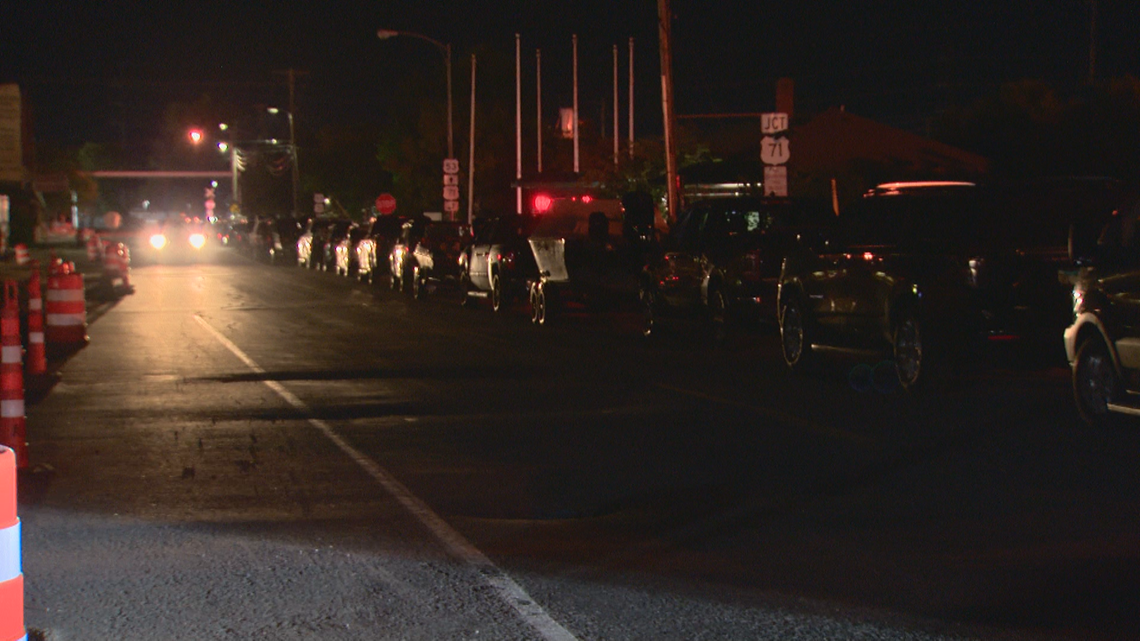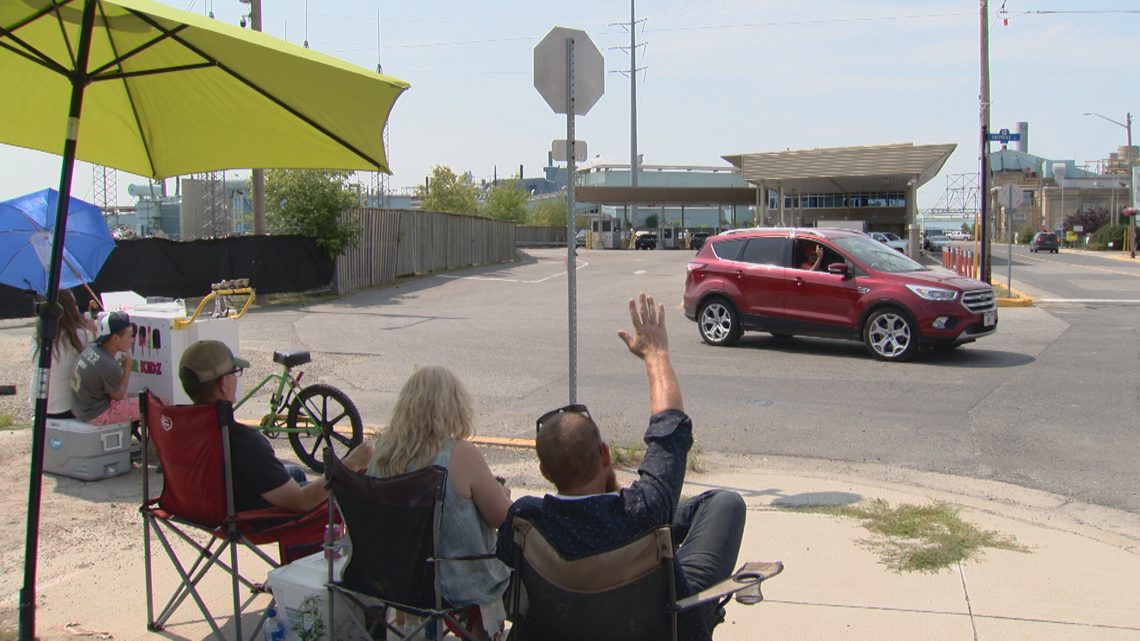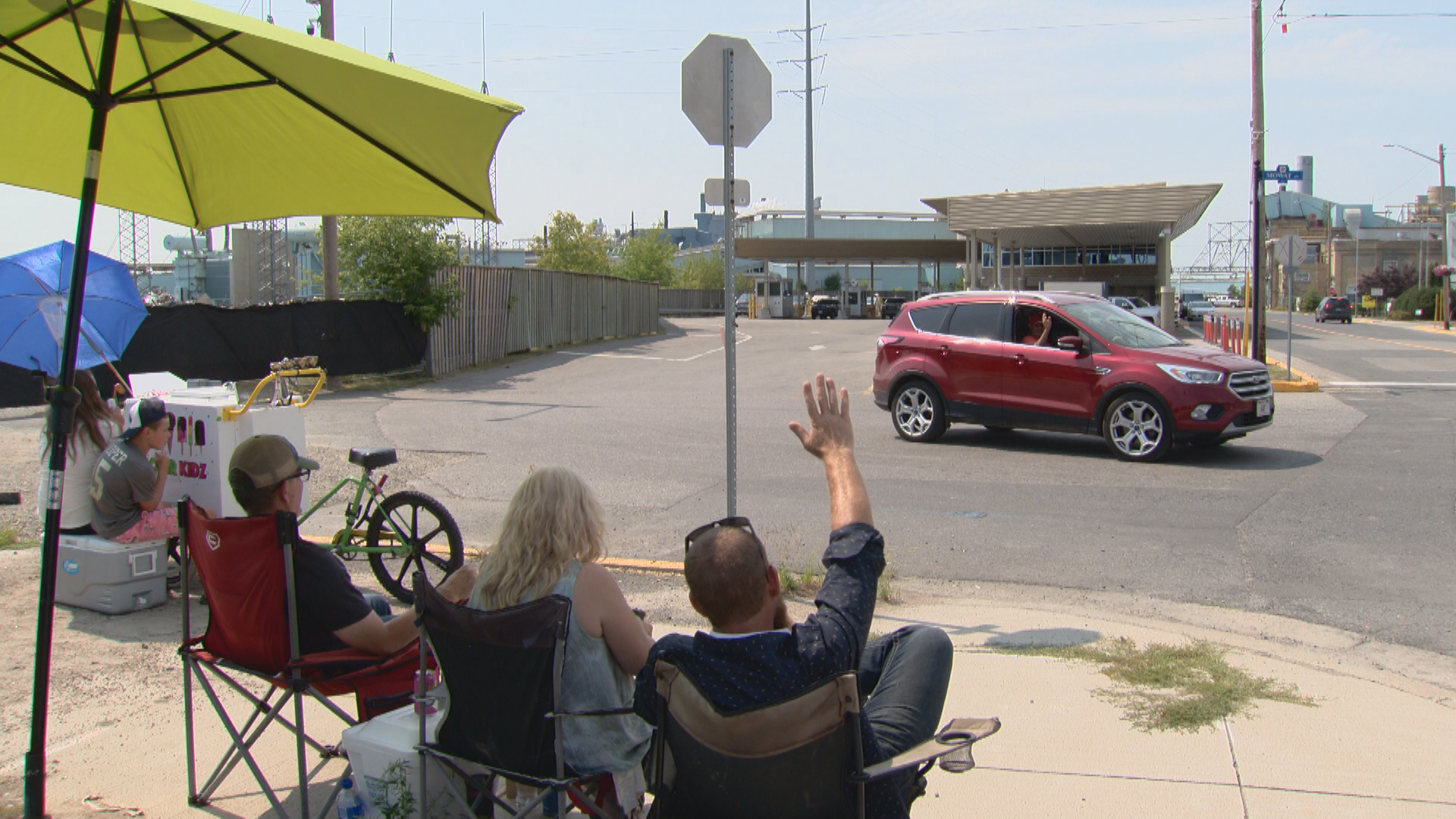INTERNATIONAL FALLS, Minn. — The Americans practically burst through International Falls late Sunday evening, lining up by the dozen at the border as they sought entry into Canada at the designated 11:01 p.m. CST reopening mark.
The parade of vehicles, stretching across train tracks and construction zones, consisted almost entirely of fishing enthusiasts and cabin owners, eagerly awaiting the chance to head north for the first time in nearly a year and a half after the Canadian government approved visitors for non-essential purposes. Most, but not all, carried Minnesota plates on their cars or boats, while others hailed from states like Iowa, Ohio, Texas, Indiana, and Arizona.
Richard Holm of West Union, Iowa, likened the mood to New Year’s Eve.
“I expect the ball to drop,” Holm said. “There should be a countdown for everyone waiting.”
When border agents ushered the first wave of cars through – right on time, at 11:01 p.m. – nobody quite knew what to expect. To gain entry into Canada, an American must upload proof of full vaccination on a special app and present a negative molecular COVID-19 test result taken within 72 hours, among other requirements.
Mike and Kathy Spanier of Prior Lake, Minnesota, heard rumors that thousands of Minnesotans would try to cross in the opening hours and that agents might spend anywhere from 20 to 40 minutes checking documents.
“Fingers crossed,” Kathy Spanier said, “it all goes smoothly.”
Spanier’s group successfully crossed into Fort Frances, Ontario, shortly before midnight. Others in the first wave, including KARE 11, entered Canada after 3 a.m.
By Monday morning, however, the average wait time stretched to an incomprehensible seven hours – by the far the longest wait time of any U.S.-Canada border crossing.
“Seven hours and 15 minutes, I believe,” an exhausted Brian Ehalt of Maple Plain, Minnesota, said Monday after grilling breakfast on his tailgate to pass the time. “At least it was a beautiful day. We had that much going for us.”


Then evening came. The line dwindled at the International Falls-Fort Frances crossing, and American fishers and campers started to flow all throughout Northwestern Ontario, paying for meals at restaurants and reserving spots at resorts.
Canada had officially opened for business.
The federal government’s move came too late for some, and too soon for others.
“WE DEPEND ON THE U.S. DOLLAR”
Paul Trinkner, the owner of two resorts in Northwestern Ontario, lounged in a lawn chair near the Fort Frances entry point on Monday afternoon and welcomed Americans crossing into Canada after a seven-hour wait. Posting “WELCOME BACK USA” signs at multiple intersections, Trinkner waved to the tourists that account for approximately 90 percent of his customers.
“We depend on the U.S. dollar,” Trinkner said. “They want to be here. They’re willing to wait seven hours if that’s what it takes. They’re excited they made it through that border – and the fishing has only gotten better, guys! I’ll tell you that much.”
Brian Ehalt, the Minnesotan who grilled breakfast while waiting in line at the border, said his trip to Canada only happened to coincide with August 9 by pure chance. He had a houseboat booked for this date a year ago, only to postpone exactly one year later due to the pandemic.
“It’s been two years since I’ve been out of the country,” he said, “and it feels great.”
The buzz of the border reopening also resonated with shop and restaurant owners in Fort Frances, including Edith Bodnar, whose family has owned Harbourage on the Rainy River for more than two decades.
Americans filled her tables, both indoor and outdoor, during the prime breakfast hours after they crossed the border Monday.
“It was a long wait, and they were just glad to be able to come back and get together with their family and go to their cabins,” Bodnar said. “We’ve missed the Americans, definitely.”
Bodnar said local patrons in Fort Frances helped them survive the most difficult months of the pandemic, but she felt the loss of international dollars last summer especially.
“It’s just nice to be busy with people,” she said. “Busy is good. We’ll take it.”
June Caul, the mayor of Fort Frances, said she the number of Americans traveling across the border on Monday was “shocking” to her.
“It’s exciting in that way, for sure,” Caul said, “especially for our tourist outfitters who were really impacted badly by the pandemic.”
Caul, however, has mixed feelings about the federal government’s decision to reopen the border to vaccinated Americans. The Rainy River District of Northwestern Ontario, according to Canadian data, has recorded only a little more than 200 cases throughout the whole pandemic – but the mayor worries increased travel might change that.
“My concern, definitely, is for people here and the people coming over,” Caul said, “to make sure that everyone remembers the COVID rules and regulations, to keep everyone and themselves safe.”
TOO SOON?
Despite the economic benefits to her region, Mayor Caul said the Canadian government opened the border prematurely for non-essential travel.
“Personally, I do,” Caul said, noting she has had ongoing discussions with other mayors in Ontario border towns as well as the federal Minister of Public Safety. “My concern has always been not opening too soon, and the big concern now, of course, is the Delta variant. We know it’s climbing everywhere.”
Two public health experts also told KARE 11 last week that Canada moved too quickly to open the border.


Dr. Kelley Lee, the Canada Research Chair in Global Health Governance at Simon Fraser University in British Columbia, called the move “premature.” The U.S. still lags almost 10 points behind Canada in full vaccination rates of the total population, and Lee predicts breakthrough cases will occur among travelers despite the testing and vaccine requirements at the border.
“With full vaccination, there’s definitely less likelihood of importing the virus, but that likelihood is not zero,” Lee said. “We do know that people who have been fully vaccinated still carry quite a high vial load – or can – if they get infected, and they can transmit the virus.”
Lee and Dr. Tom Koch, a professor of medical geography at the University of British Columbia, both told KARE 11 they believe Canada might shut down the border again at some point, although that depends on caseloads and the spread of the Delta variant in the coming weeks.
“We’re going to be watching that very carefully,” Koch said, “and I think that is a possibility. If we begin to see, especially if there’s a large super-spreader event – people coming up for a concert -- and we find upticks of cases, breakthrough but also just general cases even among the vaccinated, yes, we’ll shut it down. But, by then, the damage will be done.”
Conversely, the Biden administration has closed the U.S. border to Canada and Mexico through at least August 21.
And, just as there are differing views on the reopening in Canada, there are a wide variety of opinions about how quickly the U.S. should move at its own border.
Harley Droba, the mayor of International Falls, said he understands both perspectives but ultimately is pushing the White House to open the border with Canada. Gov. Tim Walz also signed a letter to the Biden administration seeking answers about a reopening timeline for America’s border.
“We definitely need to have these borders open,” Droba said. “We need to do it safely. But we need to do it soon.”
IMPACT ON THE AMERICAN SIDE
International Falls, Minnesota, and Fort Frances, Ontario, are roughly equal in size, each with a population hovering somewhere near 6,000 or 7,000 people. The two communities have long been intertwined. Residents of International Falls like to cross the border to utilize the Walmart in Fort Frances because they don’t have another department store nearby on the American side; on the other hand, Fort Frances residents like to shop or eat at restaurants in International Falls.
For that reason, Mayor Droba said International Falls “essentially lost half of our business overnight” when the pandemic forced the border shutdown in March 2020.
“They’re not able to come over here and use our gas stations, grocery stores, hardware stores,” Droba said. “That’s a lot of income we have in our area, the reciprocation of services.”


The border closure has also devastated families with members on both sides of the border, which is common in communities like International Falls and Fort Frances (One family, Droba said, lined up on each side of the river during the pandemic to wave toward each other across the water). Canadian restrictions have slowly eased for family members – and the border reopening will help, long lines notwithstanding – but it’s still difficult for them to see each other.
“I think that, economically, it’s been tough, but that family connection has been a lot harder for us,” Droba said. “It’s really, really tough.”
Families aside, there are some residents of Ontario who still might not be comfortable traveling to the United States, even if the Biden administration does open the border.
Fort Frances Mayor June Caul, for example, said she would count herself among those practicing extra caution.
“I won’t be in a rush for quite some time,” Caul said. “We do have to open up, sometime, for sure. But, little steps. Just baby steps at a time. And that will be the way I’d like to see it be done.”


